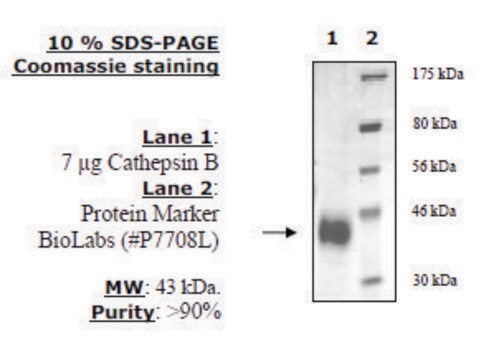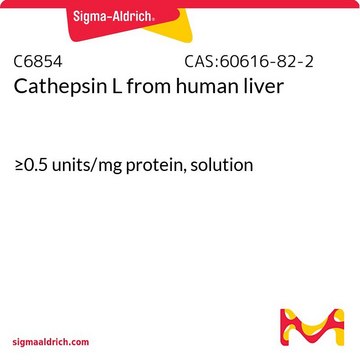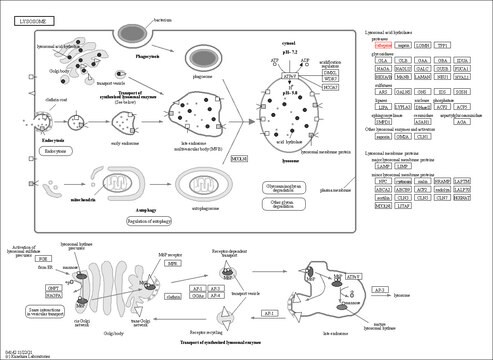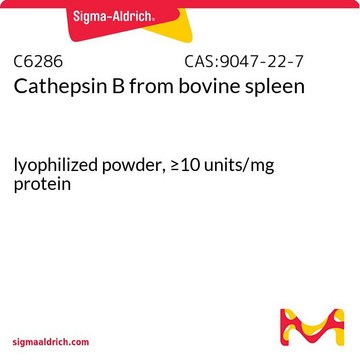SRP0292
Cathepsin S Active human
recombinant, expressed in FreeStyle™ 293-F cells, ≥90% (SDS-PAGE)
Sinonimo/i:
CTSS, MGC3886
About This Item
Prodotti consigliati
Origine biologica
human
Ricombinante
expressed in FreeStyle™ 293-F cells
Saggio
≥90% (SDS-PAGE)
Stato
aqueous solution
Attività specifica
≥8100 pmol/min-μg
PM
37 kDa
tecniche
activity assay: suitable
Compatibilità
suitable for molecular biology
N° accesso NCBI
applicazioni
life science and biopharma
Condizioni di spedizione
dry ice
Temperatura di conservazione
−70°C
Informazioni sul gene
human ... CTSS(1520)
Descrizione generale
Human cathepsin S (GenBank Accession No. NM_004079.3), CD33 signal peptide (amino acids 1-16) + cathepsin S (amino acids 17-331), with C-terminal HIS tag, MW = 37 kDa, expressed in FreeStyle 293-F cells. Cathepsin S belongs to the cysteine cathepsin protease family. It has limited tissue expression, being associated with antigen-presenting cells localized in lymph and spleen, as well as other immune cells like macrophages. Human cathepsin S is produced from its corresponding CTSS gene on chromosome 1q21 and is synthesized as a pre-proenzyme.
Applicazioni
- to assess the pathogenesis of Alzheimer′s disease.
- to investigate the optimization of selectivity of Azepanone-based inhibitors.
- for the immunocytochemical detection of cathepsin-S in mouse samples.
- for incubating mouse brain sections to test the impact of cathepsin-S on perineuronal nets (PNNs) integrity.
Azioni biochim/fisiol
Definizione di unità
Stato fisico
Nota sulla preparazione
Note legali
Avvertenze
Danger
Indicazioni di pericolo
Consigli di prudenza
Classi di pericolo
Eye Irrit. 2 - Repr. 1B - Skin Irrit. 2
Codice della classe di stoccaggio
6.1C - Combustible acute toxic Cat.3 / toxic compounds or compounds which causing chronic effects
Classe di pericolosità dell'acqua (WGK)
WGK 3
Punto d’infiammabilità (°F)
Not applicable
Punto d’infiammabilità (°C)
Not applicable
Scegli una delle versioni più recenti:
Certificati d'analisi (COA)
Non trovi la versione di tuo interesse?
Se hai bisogno di una versione specifica, puoi cercare il certificato tramite il numero di lotto.
Possiedi già questo prodotto?
I documenti relativi ai prodotti acquistati recentemente sono disponibili nell’Archivio dei documenti.
Il team dei nostri ricercatori vanta grande esperienza in tutte le aree della ricerca quali Life Science, scienza dei materiali, sintesi chimica, cromatografia, discipline analitiche, ecc..
Contatta l'Assistenza Tecnica.










